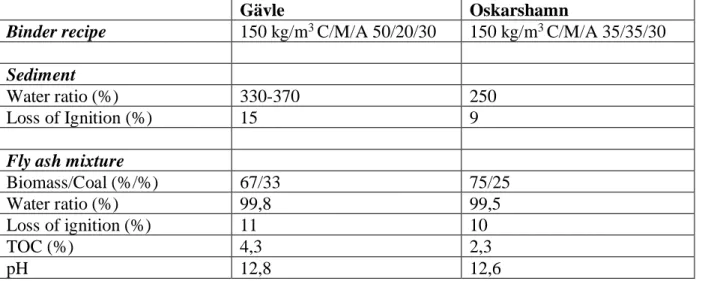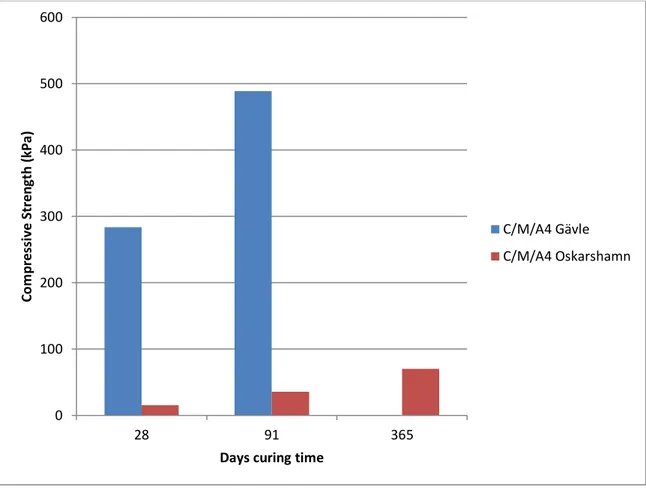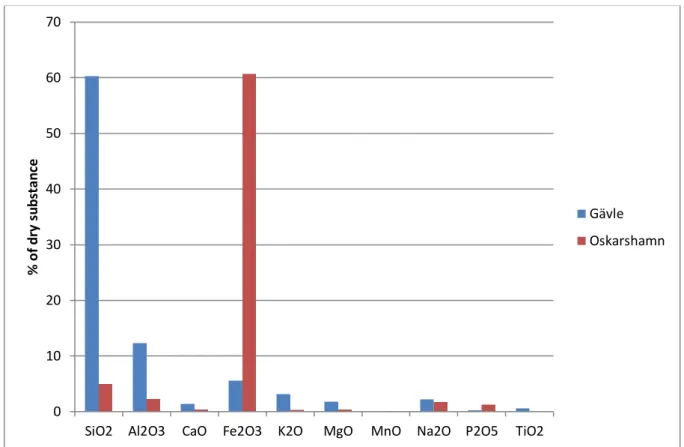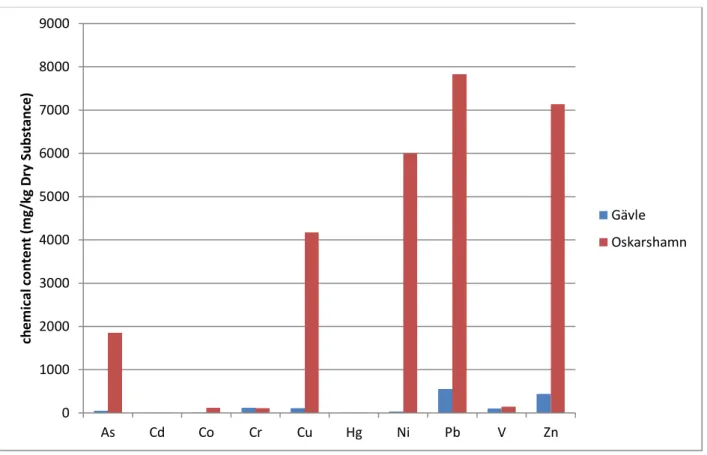FLY ASH – A POTENTIAL BINDER
COMPONENT FOR STABILISATION AND
SOLIDIFICATION OF DREDGED MATERIAL
Anna Wilhelmsson
Cowi AB, Box12076 402 41 Göteborg, SWEDEN, aawn@cowi
ABSTRACT
Over the next few years, more than one million m3 of contaminated sediments, with a muddy texture, high water ratio and low strength, shall be dredged annually in the development of ports and maintenance dredging of navigable waterways in Sweden. Dumping at sea is limited since the dredged materials are contaminated. Land disposal requires transports and land area and is thus high in costs. In the construction of new port areas, large volumes of crushed rock, etc. are normally used as construction filling materials. These materials can be replaced by stabilised and solidified dredged materials, with modified geotechnical properties. The method of stabilising / solidifying (s/s) contaminated dredged materials has been used internationally for a long period of time and in more recent years, even in the Nordic countries. In Sweden, for instance, the Port of Gävle and the Port of Oxelösund have received permissions to reuse s / s-treated contaminated dredged materials in the port structures. The Municipality of Oskarshamn have applied for permit and permission are expected in autumn 2012. The Municipality of Oskarshamn will receive funding from the Swedish Environmental Protection Agency for remediating the polluted sediments within the harbor basin. Reuse of the stabilized / solidified masses in a geotechnical structure is supported by the new Framework Directive (2008/98/EC) on waste where great emphasis is placed on recycling. Within some of the projects mentioned the potential of using fly ash as a complementary binder has been investigated. In the presentation some of the most interesting results will be presented.
KEYWORD
Fly ash, Binder, Stabilization, solidification, Dredged material.
1 BACKGROUND
Over the next few years, more than one million m3 of contaminated sediments, with a muddy
texture, high water ratio and low strength, shall be dredged annually in the development of ports and maintenance dredging of navigable waterways in Sweden. Dumping at sea is limited since the dredged materials are contaminated. Land disposal requires transports and land area and is thus high in costs. In the construction of new port areas, large volumes of crushed rock, etc. are normally used as construction filling materials. These materials can be replaced by stabilised and solidified dredged materials, with modified geotechnical properties. The
method of stabilising / solidifying (s/s) contaminated dredged materials has been used internationally for a long period of time, Holm et al. (2009) and, in more recent years, even in the Nordic countries. In Sweden, for instance, the Port of Gävle and the Port of Oxelösund have received permissions to reuse stabilized and solidified (s/s)-treated contaminated dredged materials in the port structures and there are more projects to come. Reuse of the stabilized / solidified masses in a geotechnical structure is supported by the new Framework Directive (2008/98/EC) on waste where great emphasis is placed on recycling.
The project STABCON (www.stabcon.com) has shown that a binder consisting of cement (construction cement) and Merit 5000 (steel slag), after stabilisation and solidification, can modify dredged materials so that predetermined geotechnical and environmental char-acteristics can be achieved. These masses can be used as filling materials in port structures and even replace crushed rock as filling material. Binder recipes are site specific and depend on, for example, sediment type/ dredged materials, contaminant type, contaminant content, etc. Stabilisation and solidification (s / s) means that binder is added to soft sediment / dredged materials in order to modify the strength, permeability and leaching characteristics. Contaminants are chemically transformed into less mobile forms and the masses are transformed into a solid form leading to an increased strength, improved deformation characteristics and reduced permeability of dredged materials. The use of s / s treated contaminated dredged material in geotechnical constructions have been described in STABCON by Holm et al. (2009).
In the Port of Gävle a large dredging project will start during the autumn 2012. More than 500 000 m³ of contaminated dredged materials will be stabilized and solidified and used for port structures. Within this project extensive laboratory testing was performed in order to develop a binder recipe which had the required geotechnical and environmental properties but at the same time cost efficient. Another interesting large dredging project is the one in Oskarshamn where the Municipality of Oskarshamn have received funding from the Swedish Environmental Protection Agency for remediating the polluted sediments within the harbour
basin. The dredging is planned to start in 2013 with a first smaller volume of 30 000 m3. The
rest of the dredging (> 400 000 m³)is going to start in 2014 with an execution time of 2 to 4 years.
In this paper results from development of binder recipe in laboratory scale from the Port of Gävle project will be presented. Focus will be on a separate investigation regarding the fly ash potential as a binder component. This investigation was partly financed by Värmeforsk Sweden AB. For comparison regarding the fly ash potential as a binder component some results from the project of Oskarshamn will be presented.
2 AIMS AND OBJECTIVES
The aim of the investigation was, from technical, environmental and economic aspects, to investigate the potential for a fly ash, or a combination of fly ashes, to be used as the components of a binder in the stabilisation and solidification of contaminated dredged material. The Potential assessment was carried out on five different fly ashes in a binder mix together with construction cement and Merit 5000 for s /s contaminated sediments from the Port of Gävle. The fly ashes’ potential was evaluated both by an inventory based on literature studies and interviews with fly ash producers and by laboratory investigations (characterisa-tion) of fly ashes, sediments and mixtures of binders and sediment.
3 METHOD AND PROPERTIES OF THE COMPONENTS
Within the project the Port of Gävle fly ashes were inventoried with respect to suitability and availability. Five fly ashes, both individual fly ashes and mixtures of different fly ashes, were tested in the laboratory as a binder component in a binder mix consisting of 50% cement, 20% Merit 5000 and 30% fly ash. Two of the individual fly ashes originated from biomass combustion and the third from coal combustion. Sediment from the Port of Gävle were
stabi-lised with a binder mixture amount of 150 kg/m3. Produced samples were examined in terms
of strength, permeability and leaching. An assessment of the fly ashes potential was performed based on technological, environmental and economical aspects, as well as market demand. The acceptance of stabilised and solidified dredged materials as construction material as well as the acceptance of using fly ash was also evaluated.
In the project of Oskarshamn a similar inventory was performed regarding suitability and availability of fly ashes. From the inventory two mixtures of different fly ashes were chosen and investigated in the laboratory as a binder component in a binder mix consisting of 35% cement, 35% Merit 5000 and 30% fly ash. Three of the individual fly ashes originated from biomass combustion and the fourth from coal combustion. In this paper two similar ash mixtures will be compared, see table below.
Gävle Oskarshamn
Binder recipe 150 kg/m3 C/M/A 50/20/30 150 kg/m3 C/M/A 35/35/30
Sediment
Water ratio (%) 330-370 250
Loss of Ignition (%) 15 9
Fly ash mixture
Biomass/Coal (%/%) 67/33 75/25
Water ratio (%) 99,8 99,5
Loss of ignition (%) 11 10
TOC (%) 4,3 2,3
pH 12,8 12,6
Table 1 Sediment and fly ash mixture properties for Gävle and Oskarshamn
4 RESULTS
In general the results in the Gävle project show that fly ash, together in a binder mixture with construction cement and granulated blast furnace slag (Merit 5000), has good potential as a binder. There is a correlation between the active calcium oxide (CaO) content of fly ashes and compressive strength of the stabilised samples, whereas maximum compressive strength was obtained with the fly ash with a maximum content of CaO. All stabilized samples, with an overload, passed the basic criterion of compressive strength > 140 kPa, with the lowest value being 300 kPa and with a median of just over 500 kPa after 91 days. The samples had a low
permeability between 10-8 m/s and 10-9 m/s. Leaching tests showed that the stabilised
material’s leaching of metals was low and that organic pollutants were barely detectable. A binder mixture with 30% fly ash provides a cost reduction of the binder of approximately
25%.
In the Oskarshamn project the results of compression strength for stabilized samples containing fly ash mixture in combination with cement and blast furnace slag were not so good. All stabilized samples, with an overload, had a compressive strength of 12-16 kPa after 28 days and 20-36 kPa after 91 days. In the table below compressive strength as a function of curing time are shown.
Figure 1 Compressive strength as a function of curing time. (for Gävle compression strength has not been tested after 365 days are not available)
As can be seen from the results the compression strength obtained in the Gävle project are approximately 10 times higher than the compression strength for the Oskarshamn project. One can expect a slower strength development with the recipe in the Oskarshamn project since it contains less cement on total binder and more blast furnace slag. Blast furnace slag has a slower strength development than cement. Since the binder amount is the same and the combinations of binder components are comparable there must be other parameters that influence the development of compression strength after stabilization.
As explained in the introduction the sediment properties has an influence of the stabilization, such as sediment type/ dredged materials, contaminant type and content. The sediment type is influenced by the mineral composition. In
Figure 2 below the mineral composition of the sediment from Gävle and Oskarshamn are
compared. 0 100 200 300 400 500 600 28 91 365 Co m pr essi ve St re ngt h (k Pa )
Days curing time
C/M/A4 Gävle C/M/A4 Oskarshamn
Figure 2 The mineral composition of sediment from Gävle and Oskarhamn
As can be seen the mineral composition of the two sediments are quite different. The percentage of silica and ferric (III) oxide is almost the opposite. The amount of aluminum oxide is much higher in the sediment from Gävle, over four times higher. When cement or fly ash as a binder is added to soil/sediment the pH increases to 12-13. At this pH the solubility of Si and Al from the clay mineral increase which enables the reaction with Ca from the cement/fly ash. In this reaction different faces of C-S-H and C-A-H are formed according to (1)
Ca(OH)2 Ca2+ + 2OH-
Ca+ 2OH- + SiO2 C-S-H
Ca+ 2OH- + Al2O3 C-A-H
(1)
These reactions give an increased geotechnical strength in a long-term (pozzolan) and at the same time many metals such as Arsenic (As), Chrome (Cr) and Zink (Zn). The increase in pH is also favorable for the immobilization of Lead (Pb). In the case of the stabilization of the
sediment from Oskarshamn the content of SiO2 is only one tenth compared to the sediment
from Gävle and the content of Al2O3 one fourth. These differences are probably one of the
explanations to the big difference in development of compression strength after stabilization. The chemical composition has also been compared. In Figure 3 the chemical composition of the two sediments are shown.
0 10 20 30 40 50 60 70
SiO2 Al2O3 CaO Fe2O3 K2O MgO MnO Na2O P2O5 TiO2
% o f d ry su bst an ce Gävle Oskarshamn
Figure 3 Chemical content of metals in sediment from Gävle and Oskarshamn
As can be seen the content of some of the metals, Arsenic (As), Cupper (Cu), Nickel (Ni), Lead (Pb) and Zink (Zn) is much, much higher in the sediment from Oskarshamn. For these metals the content is up to 10 times higher in the Oskarshamn sediment.
5 CONCLUSIONS
The conclusion that can be drawn when comparing results from the two projects is the following:
✓ Fly ash can be used as a binder component in combination with other binders with good compression strength for certain sediments.
✓ The same binder composition and amount can give very different results for different sediments although the sediments are similar in water ratio and organic content
✓ The mineral content of the sediments are probably important for the strength development of the stabilized masses.
✓ The importance of the mineral composition of the sediments need to be investigated more
REFERENCES
Stabcon, Holm G. Svedberg B, Eriksson K., Vägledning för nyttiggörande av muddermassor i hamn- och anläggningskonstruktioner, Statens Geotekniska Institut, Information 20 (2011) Wilhelmsson A., Holm G, Lagerlund J, Maijala A, Mácsik J, Potential assessment of using fly ash as a binding agent for stabilization and solidification of dredged material, Värmeforskrapport 1129, 2010
Lagerlund J., Jansing C, Long term effects on wet stored calcium rich fly ash with bearing on
0 1000 2000 3000 4000 5000 6000 7000 8000 9000 As Cd Co Cr Cu Hg Ni Pb V Zn ch em ic al c on ten t ( m g/ kg D ry Su bst an ce ) Gävle Oskarshamn
ground improvement work, Värmeforskrapport no1226, 2012
Johansson SE, Åhnberg H, Pihl H, Kemiska reaktionder vid stabilisering av jord, Svensk djupstabilisering, Arbetsrapport 38, 2006



